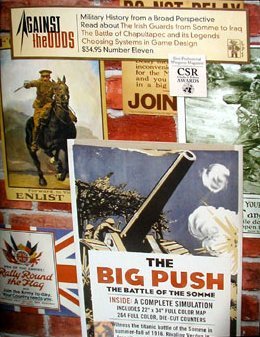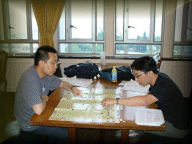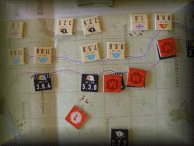ATO
magazine game Nr.11 "The
Big Push": the major British offensive in the
Somme
river area, together with their French comrades, July to November 1916.
 We
played the 4-turns scenario "Over the Top" as a learning exercise.
It took some time to get used to
the game system at the first place. So
we were just barely able to finish 3 turns in 5 hours. A
bit slower than I expected, primarily because, I think, of Roger Nord's
usual approach of introducing as many variables as possible into his
integrated design. A lot of
different die-roll modifiers have to be accounted for and calculated at the
time of resolving combats. Otherwise,
we were pretty much happy with the game's neat treatment of command
resources, where the British have more options than the Germans at the Corp
strategic planning level.
We
played the 4-turns scenario "Over the Top" as a learning exercise.
It took some time to get used to
the game system at the first place. So
we were just barely able to finish 3 turns in 5 hours. A
bit slower than I expected, primarily because, I think, of Roger Nord's
usual approach of introducing as many variables as possible into his
integrated design. A lot of
different die-roll modifiers have to be accounted for and calculated at the
time of resolving combats. Otherwise,
we were pretty much happy with the game's neat treatment of command
resources, where the British have more options than the Germans at the Corp
strategic planning level.
One
thing we tried to figure out initially was the use of the HQ for both
movement and combat. It is
because an HQ in command range and in command mode should be there for
assault commitments. At the same
time, they should be in supply mode when actual combat takes
place to avoid that nasty +2 DRM. Soon,
naturally we knew that the Brits had the advantage in the number of HQs
available! One HQ would allow
the Tommies to get close to assault. Another
HQ would supply them in combat.
 Speaking
of assaults, we were confused between assault, which is a normal one, and
close assault. In the latter,
defensive fire fire occurs before the attacker fires. While
close assault has a +1 DRM for EACH close assaulting unit to inflict greater
damage, we forgot to apply this one. We had all defenders getting to fire
first in a normal assault . . . I would have hoped that the rules for
assault should have clearly stated this, not only just a DRM description on
the Assault Results Table. The
Brits could have pushed the German back more. At
the same time, since we played it incorrectly on the close assault rule,
there was no point for the German to go over the top for a close assault,
given the fairly bloody combat results for the attacker.
Speaking
of assaults, we were confused between assault, which is a normal one, and
close assault. In the latter,
defensive fire fire occurs before the attacker fires. While
close assault has a +1 DRM for EACH close assaulting unit to inflict greater
damage, we forgot to apply this one. We had all defenders getting to fire
first in a normal assault . . . I would have hoped that the rules for
assault should have clearly stated this, not only just a DRM description on
the Assault Results Table. The
Brits could have pushed the German back more. At
the same time, since we played it incorrectly on the close assault rule,
there was no point for the German to go over the top for a close assault,
given the fairly bloody combat results for the attacker.
 So
the result is a false victory to the Germans . . . as the Allied could not
clear all the German units from the starting trench line. Actually
despite rain-clear-drizzle weather, the Brits had done well in the centre
part of
Somme
River
, breaking through the German line, with their cavalry advancing into the
trenches once vacated by the defenders. The process of Artillery bombardment
is more efficient than that found in To
the Green Fields Beyond, with lifting and creeping barrages being the
command resources for the Allied to use.
So
the result is a false victory to the Germans . . . as the Allied could not
clear all the German units from the starting trench line. Actually
despite rain-clear-drizzle weather, the Brits had done well in the centre
part of
Somme
River
, breaking through the German line, with their cavalry advancing into the
trenches once vacated by the defenders. The process of Artillery bombardment
is more efficient than that found in To
the Green Fields Beyond, with lifting and creeping barrages being the
command resources for the Allied to use.
There
are no tanks in this scenario, so we didn't get to see the tank breakdown. Replacement
is calculated by counting the number of assault steps lost and disordered
units. Most Allied units have
4-steps and the Germans have 3. Victory
points would go to the opposing side for each step replaced. Since
the Allied victory conditions hinge on territorial objectives and not VPs,
it is almost a wild spree for the German to get the replacements up and
running and sending 'em to the front via roads as soon as possible.
Overall,
we liked the game system. The
number of units and low stacking limit on the one map is very manageable and
we got used to movement on the square map grid (a very nice one by Craig
Grando) without problem. The
treatment of counter-battery fire is also fun. There
are 4 shorter scenarios (4 to 7 turns each) to choose from, dissecting each
segment in the campaign very well. Along
with the 21-turn campaign game, we will definitely give it another spin
sometime soon.

 We
played the 4-turns scenario "Over the Top" as a learning exercise.
We
played the 4-turns scenario "Over the Top" as a learning exercise.

